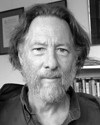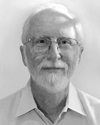|
| What Counts as Behavior? |
| Sunday, November 4, 2012 |
| 8:00 AM–10:30 AM |
| Zuni Ballroom |
| Area: TPC; Domain: Theory |
| Discussant: Raymond C. Pitts (University of North Carolina Wilmington) |
| CE Instructor: Raymond C. Pitts, Ph.D. |
| Abstract: What Counts as Behavior? |
| |
| The Molar Multiscale View of Behavior |
| WILLIAM M. BAUM (University of California, Davis) |
| Abstract: Behavior is not movement; to define behavior, we may first ask why behavior exists at all. According to evolutionary theory, behavior exists because organisms interact advantageously with the environment. Accordingly, behavior consists of getting a job done or performing a function. Examples are courtship and foraging. This definition implies that behavior must be temporally extended, because interaction with the environment cannot occur at a moment but only through time. The phrase "momentary behavior" is an oxymoron. Behavior is extended in time by its nature (i.e., by necessity). An analog to Heisenberg's uncertainty principle applies: at a moment, uncertainty of function is maximal, while uncertainty of structure is minimal; with longer periods of observation, uncertainty of function decreases, while uncertainty of structure increases. This principle applies to all behavior, including lever presses and key pecks. The principle implies also that, because activities take time, behavior entails time allocation. When choice is defined as time allocation among activities and that activities of shorter scale are nested within activities of longer scale, we conclude that all behavior entails choice and that all behavior is choice. |
 William M. Baum received his bachelor of arts degree in psychology from Harvard College in 1961. Although originally a biology major, he switched to psychology after taking courses from B. F. Skinner and R. J. Herrnstein in his freshman and sophomore years. He attended Harvard University for graduate study in 1962, where he was supervised by Herrnstein, and received his Ph.D. in 1966. He spent 1965–66 at Cambridge University, studying ethology at the Sub-Department of Animal Behavior. From 1966–1975, he held appointments as postdoctoral fellow, research associate, and assistant professor at Harvard University. He spent 2 years at the National Institutes of Health Laboratory for Brain, Evolution, and Behavior and then accepted an appointment in psychology at the University of New Hampshire in 1977. He retired from there in 1999. He currently has an appointment as associate researcher at the University of California, Davis and lives in San Francisco. His research focuses on choice, molar behavior/environment relations, foraging, and behaviorism. He is the author of a book, Understanding Behaviorism: Behavior, Culture, and Evolution. William M. Baum received his bachelor of arts degree in psychology from Harvard College in 1961. Although originally a biology major, he switched to psychology after taking courses from B. F. Skinner and R. J. Herrnstein in his freshman and sophomore years. He attended Harvard University for graduate study in 1962, where he was supervised by Herrnstein, and received his Ph.D. in 1966. He spent 1965–66 at Cambridge University, studying ethology at the Sub-Department of Animal Behavior. From 1966–1975, he held appointments as postdoctoral fellow, research associate, and assistant professor at Harvard University. He spent 2 years at the National Institutes of Health Laboratory for Brain, Evolution, and Behavior and then accepted an appointment in psychology at the University of New Hampshire in 1977. He retired from there in 1999. He currently has an appointment as associate researcher at the University of California, Davis and lives in San Francisco. His research focuses on choice, molar behavior/environment relations, foraging, and behaviorism. He is the author of a book, Understanding Behaviorism: Behavior, Culture, and Evolution. |
| |
Science and Control of the Behavior Stream Versus Freedom and the Free Operant |
| CHARLES P. SHIMP (University of Utah) |
| Abstract: Abstract: Three categories of behavior analyses can be identified, each with its own set of advantages and disadvantages. Skinner popularized a "molecular" category with his demonstrations of how to manually and powerfully shape new behaviors out of an individual behavior stream. A "molar" category involves a previously shaped activity, often a "free operant," which is assumed to be sufficiently stable so that its average rate or average duration of occurrence can be meaningfully computed, usually in order to study how reinforcement strengthens the stable response or activity. Molar analyses can be conducted independently of any known behavior stream such as when James Q. Wilson and Richard J. Herrnstein analyzed average national crime rates. This category historically derives in part from Skinner's interpretation of Ernst Mach's philosophy of science. A third category integrates molecular and molar analyses. It automates shaping to create new behavioral patterns with specified quantitative properties and shows how shaping and strengthening processes of reinforcement interact to define and control behavior. It more precisely controls behavior than the first and second categories and thereby sharply restricts "freedom,"which requires abandoning Mach's philosophyand more closely resembles science as commonly understood. |
 Charles Shimp was raised in a musical family. He attended The Ohio State University, Brown University, Stanford University, and recently retired after 43 years of working in the Psychology Department at the University of Utah. Currently, he is enjoying life in the astonishing geological diversity and beauty of Utah. His interests include his own personal mental life and its relation to the mental lives of others, listening to and performing music, and interacting with family and friends. He sees the science of behavior as having unprofitably divided between analyses of "shaping" and "strengthening," neither of which by itself can define nor explain behavior. The problem with independent analyses is that shaping and strengthening processes continuously interact. He says if he were younger, he would automate the shaping and strengthening of ever more complex behaviors such as undistracted and focused driving, writing and talking, and composing and performing music. He would even try to control the behavior streams of scientists when they talk about what science is because the verbal behavior that contributes much to the culture of behavior analysis is currently based on fragile, empirically unexamined assumptions. Dr. Shimp suspects learning how to control scientific behavior will shed light on the nature of behavior analysis, freedom, and the experience of beauty. Charles Shimp was raised in a musical family. He attended The Ohio State University, Brown University, Stanford University, and recently retired after 43 years of working in the Psychology Department at the University of Utah. Currently, he is enjoying life in the astonishing geological diversity and beauty of Utah. His interests include his own personal mental life and its relation to the mental lives of others, listening to and performing music, and interacting with family and friends. He sees the science of behavior as having unprofitably divided between analyses of "shaping" and "strengthening," neither of which by itself can define nor explain behavior. The problem with independent analyses is that shaping and strengthening processes continuously interact. He says if he were younger, he would automate the shaping and strengthening of ever more complex behaviors such as undistracted and focused driving, writing and talking, and composing and performing music. He would even try to control the behavior streams of scientists when they talk about what science is because the verbal behavior that contributes much to the culture of behavior analysis is currently based on fragile, empirically unexamined assumptions. Dr. Shimp suspects learning how to control scientific behavior will shed light on the nature of behavior analysis, freedom, and the experience of beauty. |
|
| |
| |
|
| Patterns of Explanation in Behavior Analysis: Models and Theories |
| Sunday, November 4, 2012 |
| 11:00 AM–1:30 PM |
| Zuni Ballroom |
| Area: TPC; Domain: Theory |
| Discussant: John W. Donahoe (University of Massachusetts, Amherst) |
| CE Instructor: John W. Donahoe, Ph.D. |
| Abstract: Patterns of Explanation in Behavior Analysis: Models and Theories |
| |
| Theories of Learning Are Necessary |
| PETER KILLEEN (Arizona State University) |
| Abstract: Skinner's famous article, "Are Theories of Learning Necessary?" was provocative and elliptical. The answer to his title becomes obvious when the ellipses are resolved: ... Necessary for a Science of Behavior? His own life work, in particular his three-term contingency, provided an important start on such a theory. In this talk, Skinner's work is embedded in the Aristotlean causal framework that stipulates the four questions we must answer for a complete explanation—for a complete theory—of a phenomenon; and the fifth that is entailed in the case of a dynamic process such as learning. Skinner provided two of those answers, and repudiated the others as wrong because they are extra-dimensional. This talk reasserts those questions and discusses the techniques that may be used to determine the adequacy with which provisional answers to the questions accord with the phenomenon under study. The approach is exemplified with the work of some of the participants of this conference. |
 Peter Killeen received his doctorate in 1969 under the furrowed brows of Howard Rachlin, Dick Herrnstein, and B. F. Skinner. He then absconded to Arizona State University—previously known as "Fort Skinner in the Desert." His research involved choice behavior, schedule-induced activities such as polydipsia, models of reinforcement schedules, timing, and delay discounting (additive utility model). He has received numerous reinforcers including the Woodrow Wilson Graduate Fellowship, Graduate Student Faculty of the Year, the Poetry in Science Award, and the F. J. McGuigan Lectureship on Understanding the Human Mind. He also served as a resident of the Society of Experimental Psychologists, the Society for the Quantitative Analysis of Behavior, and of the third International Seminar on Behavior. He received the Hilgard Award for the Best Theoretical Paper on Hypnosis and was featured on the "Faculty of 1,000" website (www.f1000.com) for a paper on attention deficit hyperactivity disorder. Additionally, he was covered in the "Emerging Research Front" feature on Thomson Reuters Sciencewatch for his work in inferential statistics (statistical hypothesis inference tests). Retired from teaching and administration, he continues his research on tobacco addiction, ADHD, and schedule effects and continues to mentor graduate students. He enjoys hiking in the desert mountains and admiring his grandkids. Peter Killeen received his doctorate in 1969 under the furrowed brows of Howard Rachlin, Dick Herrnstein, and B. F. Skinner. He then absconded to Arizona State University—previously known as "Fort Skinner in the Desert." His research involved choice behavior, schedule-induced activities such as polydipsia, models of reinforcement schedules, timing, and delay discounting (additive utility model). He has received numerous reinforcers including the Woodrow Wilson Graduate Fellowship, Graduate Student Faculty of the Year, the Poetry in Science Award, and the F. J. McGuigan Lectureship on Understanding the Human Mind. He also served as a resident of the Society of Experimental Psychologists, the Society for the Quantitative Analysis of Behavior, and of the third International Seminar on Behavior. He received the Hilgard Award for the Best Theoretical Paper on Hypnosis and was featured on the "Faculty of 1,000" website (www.f1000.com) for a paper on attention deficit hyperactivity disorder. Additionally, he was covered in the "Emerging Research Front" feature on Thomson Reuters Sciencewatch for his work in inferential statistics (statistical hypothesis inference tests). Retired from teaching and administration, he continues his research on tobacco addiction, ADHD, and schedule effects and continues to mentor graduate students. He enjoys hiking in the desert mountains and admiring his grandkids. |
| |
Complexity Theories in Behavior Analysis |
| JACK J. MCDOWELL (Emory University) |
| Abstract: A complexity theory is stated as a set of relatively simple rules that operate repeatedly to generate an output. The output, which typically exhibits properties and features that are not immediately derivable from the rules themselves, is then compared to the natural phenomena the theory purports to explain. At least four instances of complexity theory have appeared in behavior analysis. These are Charles P. Shimp's theory of momentary maximizing, John Donahoe and colleagues' theory of neural networks, A. Charles Catantia's theory of the reflex reserve, and Jack McDowell's theory of behavioral evolution. Each theory generates behavior by means of the rules it implements. If the generated behavior is comparable to the behavior of live organisms, then what is one warranted in asserting about the rules that constitute the theory? For example, is it important that they correspond to events and processes in the natural world? What is the nature of a theory that generates output that is consistent with observation, but that consists of rules that do not correspond, or cannot be determined to correspond, to events in the natural world? Answers to these questions may lead to a more or less maintainable distinction between a model and a theory, and to a profitable discussion of the relative value of these two types of account. |
 Jack J. McDowell received a BA from Yale University in 1972 and a Ph.D. from the State University of New York at Stony Brook in 1979. After completing his clinical internship, he joined the faculty of Emory University, where he currently serves as a professor in the Department of Psychology. Dr. McDowell also is a licensed clinical psychologist and maintains a private practice of behavior therapy in Atlanta, GA. His research has focused on the quantitative analysis of behavior. He has conducted tests of matching theory in experiments with humans, rats, and pigeons; has made formal mathematical contributions to the matching theory literature; and has proposed a computational theory of behavior dynamics. He also has written on the relevance of mathematical and computational accounts of behavior for the treatment of clinical problems. His current research is focused on his computational theory of selection by consequences, including studies of behavior generated by the theory's genetic algorithm and possible implementations of the theory in neural circuitry. His work, including collaborations with students and former students, has been funded by NIMH, NSF, and NIDA. Jack J. McDowell received a BA from Yale University in 1972 and a Ph.D. from the State University of New York at Stony Brook in 1979. After completing his clinical internship, he joined the faculty of Emory University, where he currently serves as a professor in the Department of Psychology. Dr. McDowell also is a licensed clinical psychologist and maintains a private practice of behavior therapy in Atlanta, GA. His research has focused on the quantitative analysis of behavior. He has conducted tests of matching theory in experiments with humans, rats, and pigeons; has made formal mathematical contributions to the matching theory literature; and has proposed a computational theory of behavior dynamics. He also has written on the relevance of mathematical and computational accounts of behavior for the treatment of clinical problems. His current research is focused on his computational theory of selection by consequences, including studies of behavior generated by the theory's genetic algorithm and possible implementations of the theory in neural circuitry. His work, including collaborations with students and former students, has been funded by NIMH, NSF, and NIDA. |
|
| |